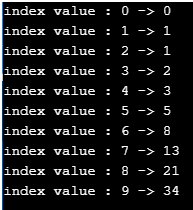斐波那契數列在於每個數字都是前兩個值總和的過程,而數列總是以基本整數 0 和 1 開始。斐波那契數與黃金比例密切相關。在本主題中,我們將了解 Java 中的斐波那契數列。
開始您的免費軟體開發課程
網頁開發、程式語言、軟體測試及其他
公式:
an = an − 2 + an − 1| Fibonacci series for first 21 numbers | ||||||||||||||||||||
| F0 | F1 | F2 | F3 | F4 | F5 | F6 | F7 | F8 | F9 | F10 | F11 | F12 | F13 | F14 | F15 | F16 | F17 | F18 | F19 | F20 |
| 0 | 1 | 1 | 2 | 3 | 5 | 8 | 13 | 21 | 34 | 55 | 89 | 144 | 233 | 377 | 610 | 987 | 1597 | 2584 | 4181 | 6765 |
以下是斐波那契數列在 Java 中的主要應用:
以下是斐波那契數列程式:
代碼:
// Fibonacci series program
public class Fibonacci {
// main program
public static void main(String[] args) {
int count = 10, var1 = 0, var2 = 1;
System.out.print("First " + count + " terms: ");
// Fibonacci series formation loop
for (int i = 1; i <= count; ++i)
{
System.out.print(var1 + " + ");
int added_sum= var1 + var2;
var1 = var2;
var2 = added_sum;
}
}
}輸出:

說明:
代碼:
for (int i = 1; i <= count; ++i)
{
System.out.print(var1 + " + ");
int added_sum= var1 + var2;
var1 = var2;
var2 = added_sum;
}因此,在此實例結束時,對於單一邏輯流,將套用下列事件:
在對給定的需要的值計數執行以下邏輯序列的過程中,可以實現斐波那契數列。
代碼:
import java.util.Arrays;
public class Main {
public static void main(String[] args) {
int Count = 15;
long[] array = new long[Count];
array[0] = 0;
array[1] = 1;
for (int x = 2; x < Count; x++) {
array[x] = array[x - 1] + array[x - 2];
}
System.out.print(Arrays.toString(array));
}
}輸出:

說明:
代碼:
public class Fibonaccifunction
{
private static int indexvalue = 0;
private static int endPoint = 9;
public static void main (String[] args)
{
int number1 = 0;
int number2 = 1;
fibonaccifunction(number1, number2);
}
public static void fibonaccifunction(int number1, int number2)
{
System.out.println("index value : " + indexvalue + " -> " + number1);
if (indexvalue == endPoint)
return;
indexvalue++;
fibonaccifunction(number2, number1+number2);
}
}輸出:

說明:
代碼:
public class Fibonacci_with_conditions
{
static int number2=1;
static int number1=0;
static int next=0;
public static void Fibonacci_conditions( int number)
{
if(number<10)
{
if(number == 0)
{
System.out.print(" "+number);
number++;
Fibonacci_conditions (number);
}
else
if(number == 1)
{
System.out.print(" "+number);
number++;
Fibonacci_conditions(number);
}
else{
next=number1+number2;
System.out.print(" "+next);
number1=number2;
number2=next;
number++;
Fibonacci_conditions(number);
}
}
}
public static void main(String[] args)
{
Fibonacci_conditions(0);
}
}輸出:

說明:
Code:
import java.util.*;
public class Fibonacci_series
{
public static void main(String[] args)
{
System.out.println("Input:");
int number= 10,value1=1,value2=0,value3=0;
num(number, value1, value2, value3);
}
public static void num(int number,int value1,int value2,int value3)
{
if(value1 <= number)
{
System.out.println(value1);
value3=value2;
value2=value1;
value1=value2+value3;
num(number,value1,value2,value3);
}
}
}Output:

Explanation:
These programs are implied to achieve the Fibonacci series for a given integer value. A largely classified set of techniques are implied in the given list of examples. Techniques like an array-oriented approach and a condition-alone approach are very much peculiar.
以上是Java 中的斐波那契數列的詳細內容。更多資訊請關注PHP中文網其他相關文章!




